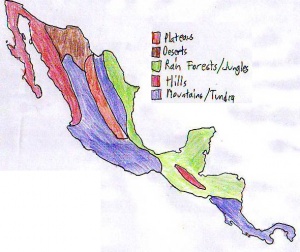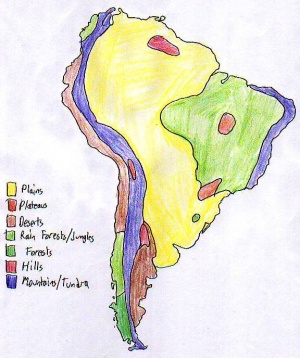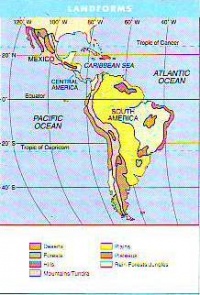Difference between revisions of "World Cultures Portfolio/Latin America"
From ThePlaz.com
(fix sources) |
(alphabetize) |
||
| Line 32: | Line 32: | ||
==Sources== | ==Sources== | ||
| − | |||
*Ahmad, Ifikhar, Herbert Brodsky, Marylee Susan Crofts, and Elisabeth Gaynor Ellis. <u>World Cultures: A Global Mosaic</u>. Upper Saddle River, New Jersey: Prentice Hall, 2001. | *Ahmad, Ifikhar, Herbert Brodsky, Marylee Susan Crofts, and Elisabeth Gaynor Ellis. <u>World Cultures: A Global Mosaic</u>. Upper Saddle River, New Jersey: Prentice Hall, 2001. | ||
| + | *<u>Global Insights: People and Cultures</u>. Glencoe/McGraw-Hill, 1993. | ||
*"Latin America Climate Map." Encarta. Microsoft. 17 Jan 2007 <http://encarta.msn.com/encnet/features/MapCenter/MapPrintPreview.aspx?lat=19.4330220000885&long=-99.1399362555466&alt=4&mapsize=Medium&mapstyle=climate&mapstyleselectedindex=8&selectedent=10101474&entityname=Latin%20American%20Tower%20%5BTorre%20Latinoamericana%5D%20(building),%20Mexico%20City,%20Mexico>. | *"Latin America Climate Map." Encarta. Microsoft. 17 Jan 2007 <http://encarta.msn.com/encnet/features/MapCenter/MapPrintPreview.aspx?lat=19.4330220000885&long=-99.1399362555466&alt=4&mapsize=Medium&mapstyle=climate&mapstyleselectedindex=8&selectedent=10101474&entityname=Latin%20American%20Tower%20%5BTorre%20Latinoamericana%5D%20(building),%20Mexico%20City,%20Mexico>. | ||
Latest revision as of 03:59, 19 January 2007
World Cultures Latin American Report about Landforms
Intro/Basics - Africa - Middle East - South Asia - China - Japan - Korea - Latin America
Only spent half a day on this unit World Cultures Daily Questions
Notebook
- Page 101 - Central American Map, South American Map, Geo Notes, Page 2
- Page 102 - Latin American Notes, Page 2, Page 3, Page 4, Page 5, Page 6, Page 7, Page 8, Page 9
Portfolio
- Portfolio
- Landforms Report
Africa: HDI Graph Reflections - Decolonization Report
Middle East: Population Density Report - Essay: A Peaceful Vacation
South Asia: Rainfall Report - South Asia Comparisons Graph - Postcards
China: Sphere of Influences Report - Mao Button Journal
Japan: Natural Resources Report - Japanese Violence Journal
Korea: Physical Map Report
Latin America: Landforms Report
Worldwide: T-Shirt Trade Report
Latin America stretches 5,500 long miles from the Rio Grande River to the tip of Cape Horn (Ahmad et al 441). The region receives its name from the Latin people who first "discovered" it centuries ago (Ahmad et al 441). The region stretched from tropical rain forests to icy wastelands near Antarctic (Ahmad et al 441). Latin America, a vast collection of different sub-regions, means that not just one story exists about Latin American landforms. Latin America contains Mexico, 7 nations of Central America, Puerto Rico and 13 other Caribbean nations, along with the 14 nations of South America (Ahmad et al 441). Latin America covers 20% of the earth's land surface area. Thus its landforms represent one of the most diverse collections on earth.
Much of the geography of Latin America gets affect by the La Cordillera mountain range (Ahmad et al 441). These mountains run the entire length of Latin America and even extend into North America (Ahmad et al 441). The name might not sound familiar because the mountains have different names in the different regions. The United States calls its section the Rocky Mountains. In Mexico, the Sierra Madres affect most of Mexico. The chain continues down through Central America, no doubt the force which created that land bridge. In South America, the mountains hug the western cost of the country leaving little coastal plains facing the Pacific Ocean. The mountains, as seen before, cut off the rain clouds from crossing them. Thus the Atacama Desert exists in Chile (Ahmad et al 441). Some parts of it have not received rain in 400 years (Ahmad et al 441)!
The land bridge of Central American can also explain a lot. Thousands of years before the Europeans "discovered" South America, native peoples must have traveled across that thin strip of land to find the vast continent of South America. These people must have also crossed over from Russia centuries before that. That land bridge, however, no longer stands above the water.
In the north of Latin America lies Mexico. Below the Rio Grande River, the deserts of the American west continue. Although the map doesn't show it, the Baja Peninsula often gets considered a desert. The Sierra Madere mountains and Central Plateau in central Mexico do not make this a good spot for agriculture. However the wide plains and prairies make this a good spot for the iconic cowboys herding cattle, so often seen in classic movies.
Moving down into Central America, one finds rain forests. Rain forests grow in the hot, humid lowlands near the equator. Mountain ranges and hills sometimes intersperse themselves throughout the desert, but for the most part, the rain forests make up the lowlands.
The west side of South America follows a similar pattern. Deserts lie sandwiched between the ocean and the high Andes Mountains, the second tallest mountain range on earth (Ahmad et al 442). Near the southern tip of South America, however, the sandwiched area turns to forests because of the precipitation blowing up from Antarctica (Ahmad et al 445). This makes the land cooler and less harsh.
However, for the most part, the eastern half of South America, of which Brazil comprises mostly of, plains and jungles lie. The Amazon Basin takes up 40% of Latin America and comprises of mostly rain forests, however the textbook map lists it as plains (Ahmad et al 442). Perhaps jungles surround only the lower section of the river. This area, from the snowy Andes Mountains in Peru, sources the great Amazon River. Ships can travel up to 2,300 miles into the Amazon, opening up an essential shipping route. Lumbar, livestock, and minerals make up the primary exports of the region (Ahmad et al 443). These resources then get traded for other goods in the world marketplace. Thus this represents a positive force for possible economic growth in the region. However, corruption, ramped in Latin America, reduces any possible benefits to the general population. These government problems need attention first if Latin America wishes to solve its economic problems.
At the very eastern side of South America, the Brazilian Highlands separate the Amazon Basin from the Atlantic Ocean (Red book map). Because these mountains do not extend as high, the rainfall effect does not happen as much here. However, it might still block some of the trade and restrict possible agricultural activities.
Below the Brazilian Highlands, but still to the east of the great mountains, lies Argentina. Deserts comprise its lower half, but plains extend above it and into the Amazon Basin. Closer to the Andes and Chile, lie the "pampas" or grassy plains (Ahmad et al 442). Here wheat farmers and cattle ranchers make up one of the most productive farming regions of Latin America (Ahmad et al 442). Again people will adapt to their geography and make the most of their surroundings.
All of these geographical dividers separate Latin America into smaller sub-regions. Not until the Europeans arrived did the region even think of itself as a whole. The people, it seemed, did not go exploring far to discover and trade with other cultures. This contributed to regionalism, separating the different cultures of Latin America (Ahmad et al 442). This means that they developed separately unlike other, smaller regions we studied like Japan and Korea. In addition, the Americas existed quite far away for the trade and culture surrounding the Mediterranean Sea, the cradle of modern civilization. Only recently did the Europeans come over, and when they did, they did not see themselves as equals with the people they conquered. Even parts the East had more contact to Europe, unless they themselves decided to abolish that contact.
But whatever landform exists in a certain part of Latin America, one can know that it had some kind of effect on the peoples of Mexico, the Caribbean, Central, and South America. Centuries ago, Spanish and Portuguese settlers, the Latin people, found the vast expanses of Latin America and called it their own. They too affected the people, but, also they did fall victim to geography. They did not fulfill their quest for gold. The tall La Cordillera mountain range runs the length of two continents and affects much of the daily life such as the direction of the river's flow. But Latin America remains a large collection of smaller sub-regions each with its own problems and landforms.
Sources
- Ahmad, Ifikhar, Herbert Brodsky, Marylee Susan Crofts, and Elisabeth Gaynor Ellis. World Cultures: A Global Mosaic. Upper Saddle River, New Jersey: Prentice Hall, 2001.
- Global Insights: People and Cultures. Glencoe/McGraw-Hill, 1993.
- "Latin America Climate Map." Encarta. Microsoft. 17 Jan 2007 <http://encarta.msn.com/encnet/features/MapCenter/MapPrintPreview.aspx?lat=19.4330220000885&long=-99.1399362555466&alt=4&mapsize=Medium&mapstyle=climate&mapstyleselectedindex=8&selectedent=10101474&entityname=Latin%20American%20Tower%20%5BTorre%20Latinoamericana%5D%20(building),%20Mexico%20City,%20Mexico>.





